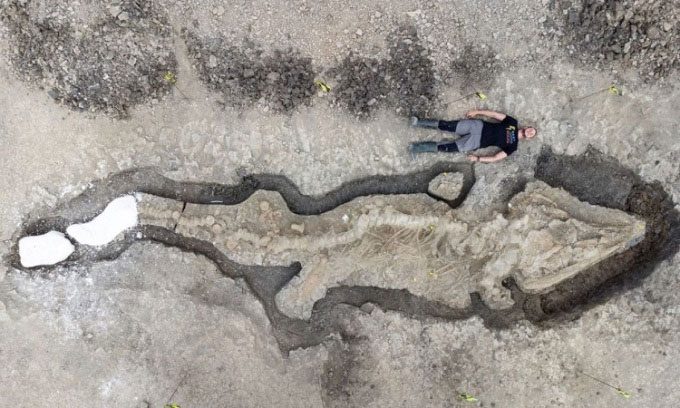Paleontologists Discover Giant Skeleton of a Ichthyosaur That Lived in the English Seas 180 Million Years Ago
Joe Davis discovered the fossil at the Rutland Water Nature Reserve in England in January 2021. Davis, the conservation team leader, noticed several fossilized bones protruding from the ground while draining water from the site. At first, the fossil appeared to belong to a gigantic dinosaur. However, when paleontologist Dean Lomax examined the photographs, he immediately recognized that Davis had found a massive marine reptile known as an ichthyosaur.

The Rutland fossil is a rare complete skeleton of a marine reptile. (Photo: Anglian Water).
Ichthyosaurs coexisted with dinosaurs, but they had a completely different shape and structure. Ichthyosaurs evolved from land reptiles during the Triassic period, approximately 246 million years ago. Over time, their bodies became elongated and more fish-like. These marine reptiles thrived in the oceans until about 95 million years ago.
Many ichthyosaur species were similar in size to modern sharks, specializing in hunting fish, squid, and other small prey. Some species were apex predators, often targeting large marine reptiles. To date, the largest ichthyosaur known to have lived during the Triassic period existed between 250 and 201 million years ago.
The fossil found in Rutland dates back approximately 180 million years and belongs to a colossal creature. According to paleontologist Rebecca Bennion from the University of Liège, finding such a large and complete fossil is a remarkable discovery. The skull alone is nearly 2.1 meters long, while the entire body measures over 10 meters, comparable to a modern minke whale.
Researchers spent more than two weeks excavating the skull. According to Lomax, this is one of the most complete prehistoric reptile skeletons ever discovered in England. Although the discovery has not yet been described in an official report, Jorge Velez-Juarbe, a paleontologist at the Natural History Museum of Los Angeles County, stated that the fossil will provide new insights into the evolutionary history of marine reptiles.
The research team is still excavating the Rutland ichthyosaur fossil. However, Lomax and his colleagues have conducted all possible measurements and taken thousands of photographs to create a 3D model of the skeleton. They currently hypothesize that the skeleton belongs to the ichthyosaur Temnodontosaurus trigonodon, which is only known from isolated bones found in Jurassic rock layers in Germany. At the beginning of the Jurassic period, 180 million years ago, T. trigonodon was the largest marine predator on the planet.
Another ichthyosaur may have attempted to prey on the individual in Rutland. Excavation experts found several Temnodontosaurus teeth around the skeleton, which could be remnants of scavenging behavior, Lomax noted.
Several ichthyosaur species as large as whales evolved in the early Triassic but disappeared during the mass extinction event 201 million years ago. The surviving ichthyosaurs gradually became smaller, but some species later grew in size again. By examining the teeth of the new specimen, paleontologists can learn about the diet and ecological role of the Rutland ichthyosaur in the late Jurassic ecosystem.





















































